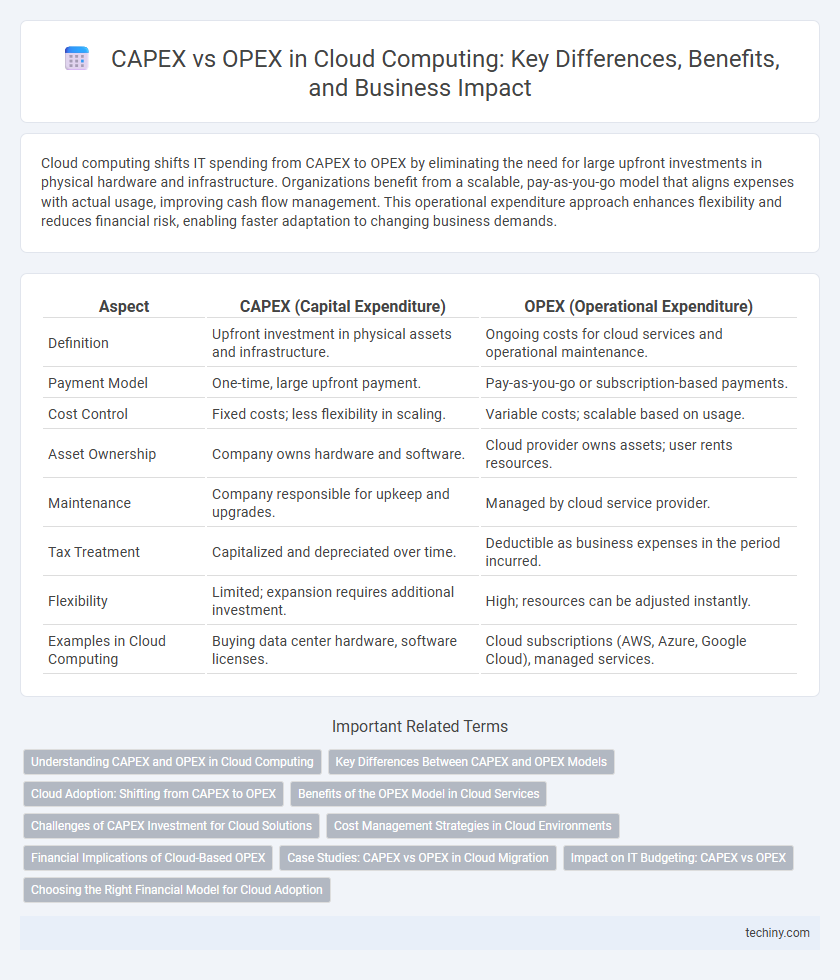Cloud computing shifts IT spending from CAPEX to OPEX by eliminating the need for large upfront investments in physical hardware and infrastructure. Organizations benefit from a scalable, pay-as-you-go model that aligns expenses with actual usage, improving cash flow management. This operational expenditure approach enhances flexibility and reduces financial risk, enabling faster adaptation to changing business demands.
Table of Comparison
| Aspect | CAPEX (Capital Expenditure) | OPEX (Operational Expenditure) |
|---|---|---|
| Definition | Upfront investment in physical assets and infrastructure. | Ongoing costs for cloud services and operational maintenance. |
| Payment Model | One-time, large upfront payment. | Pay-as-you-go or subscription-based payments. |
| Cost Control | Fixed costs; less flexibility in scaling. | Variable costs; scalable based on usage. |
| Asset Ownership | Company owns hardware and software. | Cloud provider owns assets; user rents resources. |
| Maintenance | Company responsible for upkeep and upgrades. | Managed by cloud service provider. |
| Tax Treatment | Capitalized and depreciated over time. | Deductible as business expenses in the period incurred. |
| Flexibility | Limited; expansion requires additional investment. | High; resources can be adjusted instantly. |
| Examples in Cloud Computing | Buying data center hardware, software licenses. | Cloud subscriptions (AWS, Azure, Google Cloud), managed services. |
Understanding CAPEX and OPEX in Cloud Computing
Understanding CAPEX and OPEX in cloud computing is essential for optimizing IT budgets and operational efficiency. CAPEX, or capital expenditures, refers to upfront investments in physical hardware and infrastructure, while OPEX, or operational expenditures, involves ongoing costs such as subscription fees, maintenance, and cloud service usage. Cloud computing shifts traditional CAPEX-heavy models to OPEX-focused spending, enabling scalable resource allocation and improved cash flow management.
Key Differences Between CAPEX and OPEX Models
CAPEX (Capital Expenditure) involves upfront investments in physical IT infrastructure, such as servers and data centers, leading to higher initial costs and long-term depreciation. OPEX (Operational Expenditure) focuses on pay-as-you-go expenses, including subscriptions and cloud services, allowing organizations to scale resources dynamically and reduce financial risk. The key differences center on spending timing, flexibility, and accounting treatment, with CAPEX tied to asset ownership and OPEX reflecting ongoing operational costs.
Cloud Adoption: Shifting from CAPEX to OPEX
Cloud adoption drives a strategic shift from CAPEX to OPEX, enabling businesses to convert large upfront investments in hardware and infrastructure into flexible, pay-as-you-go operational expenses. This transition enhances financial agility, allowing companies to scale resources dynamically based on demand, optimize cash flow, and reduce the risks associated with overprovisioning. Cloud service models such as IaaS and PaaS further promote OPEX by providing managed services, minimizing capital expenditures while maximizing operational efficiency.
Benefits of the OPEX Model in Cloud Services
OPEX in cloud services offers scalable cost management by converting large upfront capital expenditures (CAPEX) into predictable operational expenses, enabling businesses to pay only for the resources they actually use. This model enhances financial flexibility, reduces the risk of overprovisioning, and accelerates time-to-market by eliminating the need for extensive hardware investments. Companies can optimize cash flow and focus on core competencies while leveraging cloud providers' infrastructure, maintenance, and security expertise.
Challenges of CAPEX Investment for Cloud Solutions
CAPEX investment in cloud solutions requires substantial upfront capital, leading to resource allocation challenges and reduced financial flexibility for enterprises. Predicting long-term infrastructure needs is complex, increasing the risk of overprovisioning or underutilization, which negatively impacts cost efficiency. This inflexibility hinders rapid adaptation to evolving cloud technologies and market demands, limiting innovation and scalability.
Cost Management Strategies in Cloud Environments
Effective cost management strategies in cloud environments emphasize shifting from capital expenditure (CAPEX) to operational expenditure (OPEX) models to optimize financial flexibility and scalability. Cloud service providers offer pay-as-you-go pricing, enabling businesses to align expenses directly with usage and avoid large upfront investments in infrastructure. Employing tools like cloud cost monitoring, budgeting, and automated scaling further minimizes waste and enhances budget control in dynamic cloud ecosystems.
Financial Implications of Cloud-Based OPEX
Cloud-based OPEX transforms traditional CAPEX by shifting large upfront infrastructure investments to scalable, pay-as-you-go operational expenses, improving cash flow management and financial flexibility. This model enables businesses to align IT costs with actual usage, reducing risk from overprovisioning and obsolete hardware. Companies benefit from predictable budgeting and enhanced agility in responding to market demands through dynamic resource allocation.
Case Studies: CAPEX vs OPEX in Cloud Migration
Several case studies demonstrate significant cost reductions when businesses shift from CAPEX to OPEX models during cloud migration, highlighting improved cash flow and scalability. For instance, a retail company reduced upfront hardware investments by 40% while achieving flexible resource allocation through OPEX-based cloud subscriptions. Another technology firm reported 30% operational expense savings by avoiding data center maintenance and leveraging pay-as-you-go cloud infrastructure, emphasizing the financial agility offered by OPEX in dynamic environments.
Impact on IT Budgeting: CAPEX vs OPEX
CAPEX involves significant upfront investments in hardware and infrastructure, resulting in higher initial costs but predictable depreciation schedules that impact long-term IT budgeting. OPEX shifts expenses to operational costs, enabling businesses to adopt pay-as-you-go cloud services, which provide flexibility and improved cash flow management in IT budgets. This shift from CAPEX to OPEX reduces the need for large capital expenditures and allows IT budgets to scale dynamically with organizational demand.
Choosing the Right Financial Model for Cloud Adoption
Capital Expenditure (CAPEX) involves significant upfront investments in physical infrastructure, which can limit agility and increase financial risk during cloud adoption. Operational Expenditure (OPEX) offers a pay-as-you-go model that aligns costs with usage, enabling scalable resource management and improved cash flow. Selecting the appropriate financial model depends on organizational goals, workload variability, and long-term scalability requirements in cloud computing environments.
CAPEX vs OPEX Infographic

 techiny.com
techiny.com